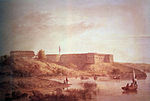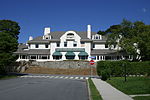Monte Cristo Cottage
Biographical museums in ConnecticutHistoric house museums in ConnecticutHouses completed in 1888Houses in New London, ConnecticutHouses on the National Register of Historic Places in Connecticut ... and 6 more
Literary museums in the United StatesMuseums in New London County, ConnecticutNational Historic Landmarks in ConnecticutNational Register of Historic Places in New London County, ConnecticutTourist attractions in New London, ConnecticutUse mdy dates from August 2023

Monte Cristo Cottage (also known as Eugene O'Neill Summer House) was the summer home of American actor James O'Neill and his family, notably his son Eugene O'Neill. It is a National Historic Landmark located at 325 Pequot Avenue in New London, Connecticut.
Excerpt from the Wikipedia article Monte Cristo Cottage (License: CC BY-SA 3.0, Authors, Images).Monte Cristo Cottage
Pequot Avenue, New London
Geographical coordinates (GPS) Address External links Nearby Places Show on map
Geographical coordinates (GPS)
| Latitude | Longitude |
|---|---|
| N 41.331944444444 ° | E -72.09625 ° |
Address
Pequot Avenue 325
06320 New London
United States
Open on Google Maps








